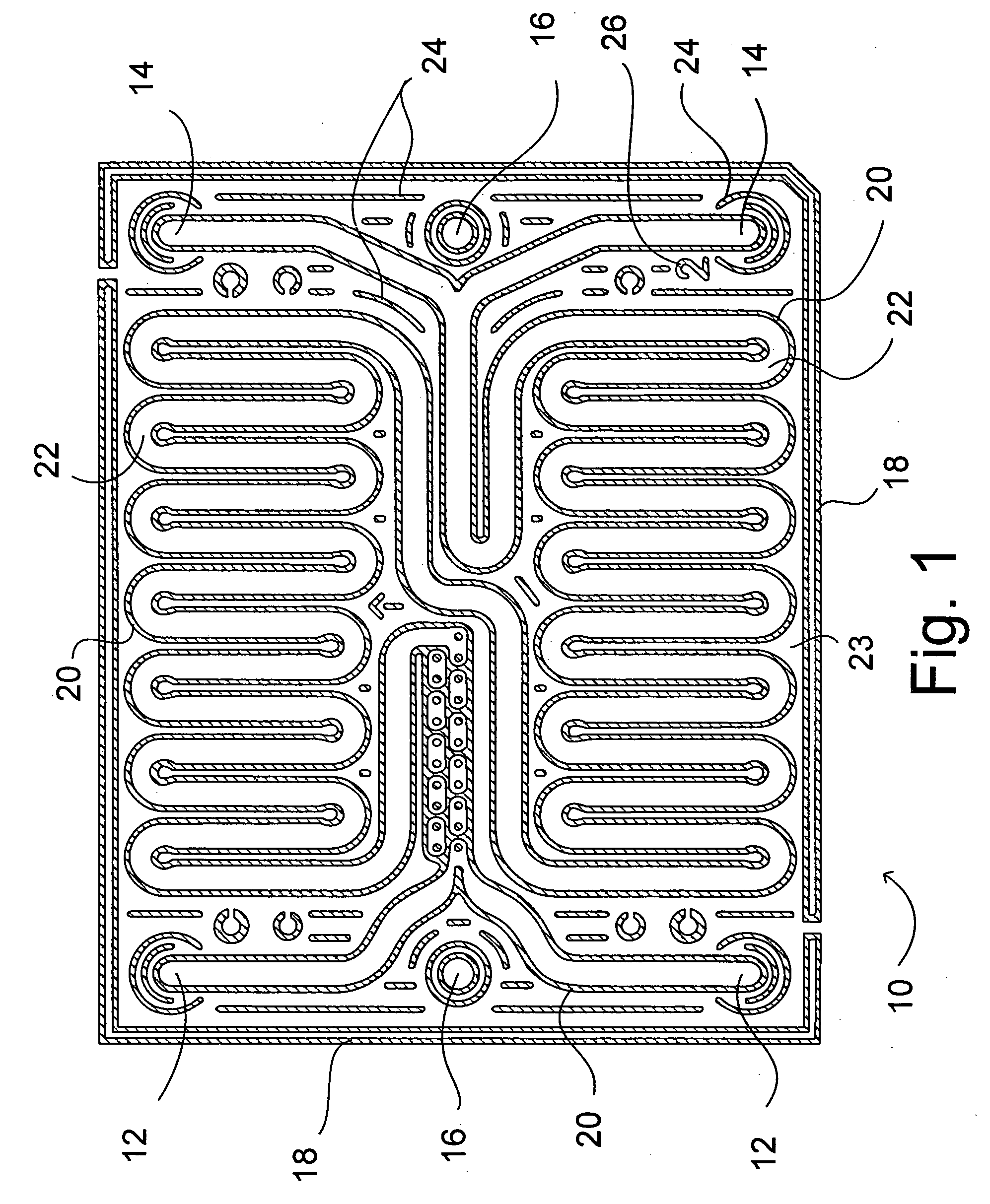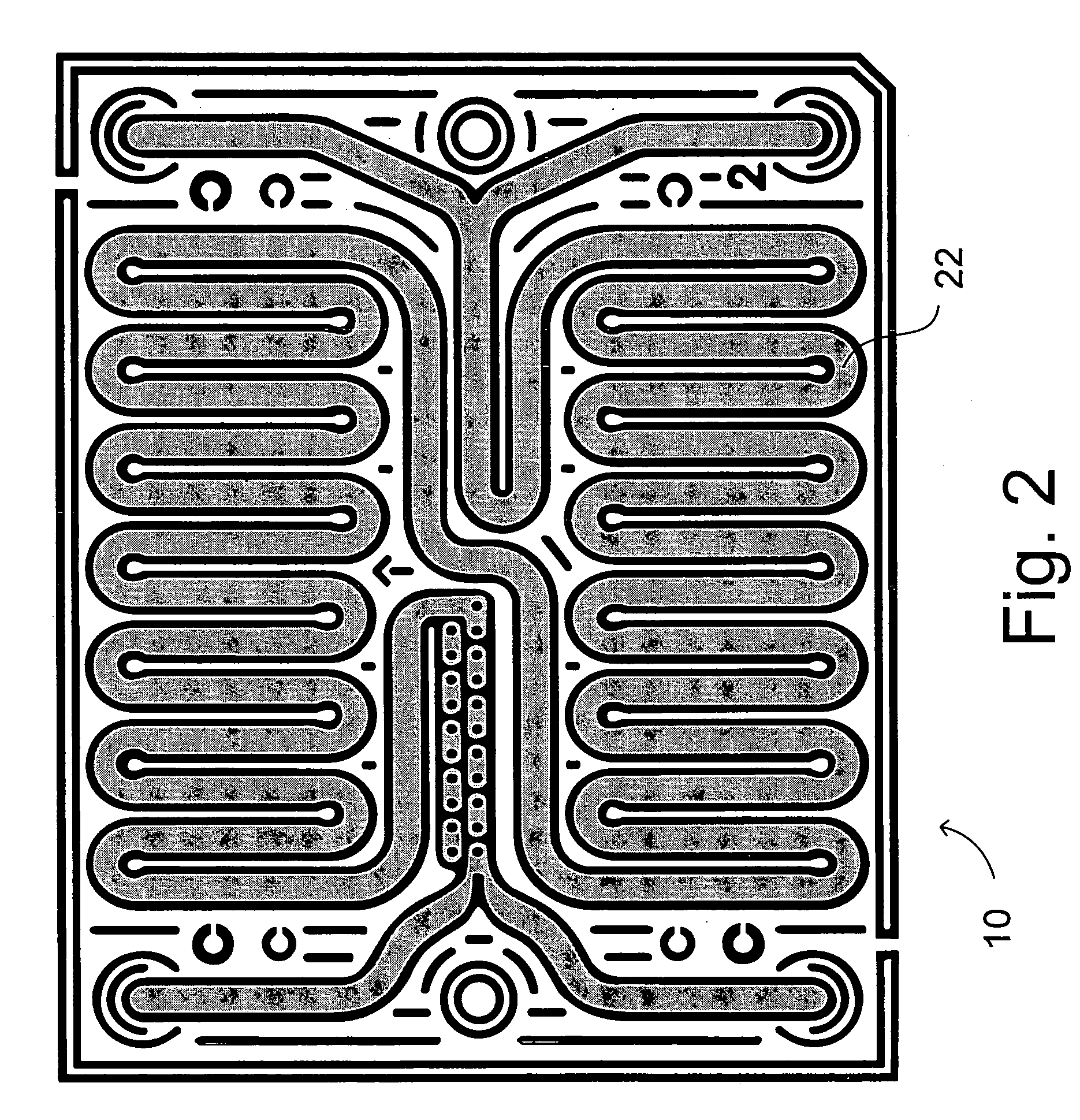High performance microreaction device
a micro-reaction device, high-performance technology, applied in indirect heat exchangers, laboratory glassware, lighting and heating apparatus, etc., can solve the problems of inability to clean, difficult disassembly and cleaning, and difficulty in cleaning, etc., to achieve fast mixing performance, low pressure drop performance, and fast mixing performance
- Summary
- Abstract
- Description
- Claims
- Application Information
AI Technical Summary
Benefits of technology
Problems solved by technology
Method used
Image
Examples
examples
[0066] A testing method used to quantify mixing quality of two miscible liquids is described in Villermaux J., et al. “Use of Parallel Competing Reactions to Characterize Micro Mixing Efficiency,” AlChE Symp. Ser. 88 (1991) 6, p. 286. For testing generally as described herein, the process was to prepare, at room temperature, a solution of acid chloride and a solution of potassium acetate mixed with KI (Potassium Iodide). Both of these fluids or reactants were then continuously injected by means of a syringe pump or peristaltic pump into the micromixer or microreactor to be tested.
[0067] The resulting test reaction results in two competing reactions of different speeds—a “fast” reaction that produces a UV absorbing end product, and an “ultrafast” one that dominates under ultrafast mixing conditions, producing a transparent solution. Mixing performance is thus correlated to UV transmission, with theoretically perfect or 100% fast mixing yielding 100% UV transmission in the resulting ...
performance example i
Mixing Performance, Pressure Drop and Dwell Time
[0070] Mixing tests performed as described above were made on nine different samples of the embodiment of the present invention shown in FIGS. 1-5, 8-10, 12 and 13 above. Average fast mixing performance as a function of flow rate is shown by the data 100 plotted in the graph in FIG. 15, and average pressure drop as a function of flow rate is shown by the data 200 plotted in the graph in FIG. 16. Fast mixing resulting in 90% measured mixing performance or greater is present from a range of flow rates beginning just below 20 ml / min and upward, corresponding to a minimum pressure drop of slightly less than 90 mBar. Residence times or “dwell times” as function of flow rate are plotted as data 300 in FIG. 17.
performance example ii
Repeatability and Durability of Mixing
[0077] Fast mixing tests performed as described above were made at 20 ml per minute flow rate on nine different samples of the embodiment of the present invention shown in FIGS. 1-10, 12 and 13, and the range of values was compared. Transmission percentage results ranged from 93 to 95% at 20 ml / min. flows. Repeatability in the same device was also very good at ±1%.
[0078] Samples of devices according to the present invention, formed in glass according to the process referenced above, were also subjected to alkaline corrosion by flowing 1N (1M) NaOH solution at 95° C. through the reactant passage(s) at 20 ml / min. Pressure drop as a function of flow rate, total internal volume, and mixing performance were tested after 0, 100, 200 and 300 hours of such corrosion. After 300 hours of corrosion, internal volume increased by about 30% and pressure drop was reduced by half. Mixing performance, however, remained essentially stable over the duration of t...
PUM
| Property | Measurement | Unit |
|---|---|---|
| Pressure | aaaaa | aaaaa |
| Flow rate | aaaaa | aaaaa |
| Volume | aaaaa | aaaaa |
Abstract
Description
Claims
Application Information
 Login to View More
Login to View More - R&D
- Intellectual Property
- Life Sciences
- Materials
- Tech Scout
- Unparalleled Data Quality
- Higher Quality Content
- 60% Fewer Hallucinations
Browse by: Latest US Patents, China's latest patents, Technical Efficacy Thesaurus, Application Domain, Technology Topic, Popular Technical Reports.
© 2025 PatSnap. All rights reserved.Legal|Privacy policy|Modern Slavery Act Transparency Statement|Sitemap|About US| Contact US: help@patsnap.com



